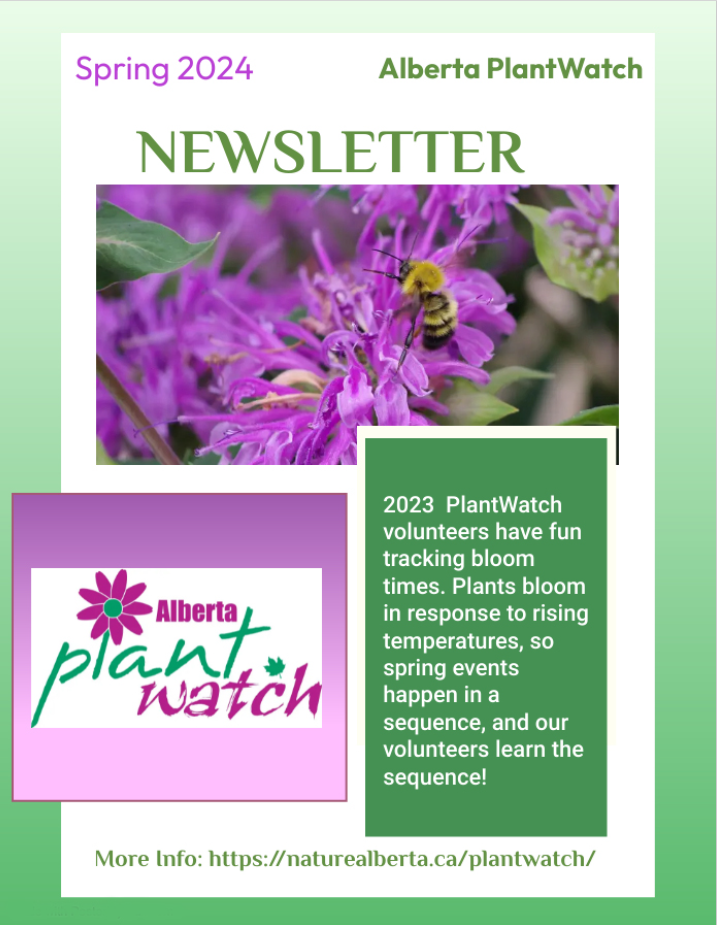PlantWatch
By reporting when certain plants bloom and leaf out in spring, Albertans contribute vital information for climate change studies. The speed of spring plant development is controlled mainly by temperature. Warming winter and spring temperatures mean earlier appearances of flowers.
This study of biological timing is called phenology, “the science of appearances.” Besides contributing to climate and ecological research, your contributions help to predict allergy seasons, forest fires, pest control, the optimal timing of seed planting, and even when to go fly fishing.
General Instructions
The Plantwatch program monitors 26 species. If you are starting out, pick one or two species that are easy to recognize and that you can easily observe on a regular basis, such as dandelion, strawberry, or saskatoon. Note that some of the tree species in the project are more challenging to monitor because you need to recognize male from female catkins or cones, and this takes practice. Before you begin monitoring, please familiarize yourself with the species you have selected and their specific monitoring instructions (see Plantwatch Species, below).
When selecting plants to observe, choose a specimen that reflects average flowering for your area (i.e., not the earliest or latest to flower). Also, choose plants that well away from buildings and fences (heat sources) and preferably in a flat area.
If you can, please observe the same individual tree, shrub or patch of plants from year to year. To do this, it helps to mark your plants in some way, or at least note some landmarks nearby.
Submitting Observations
Please begin watching your chosen plant as it develops in spring, before it flowers. By starting early you will be able to accurately document the date of first bloom. We also would like you to record the date of mid bloom. If you have chosen a woody species, we would like you to record the date that leaves first appear. Descriptions of these three stages are listed below. However, some species have special instructions. So please review the "how to observe" section of your chosen plant(s) by clicking on the species name in "Plantwatch Species" list below.
- First bloom. For wildflowers, first bloom is when the first flowers open in the plants under observation. For trees and large shrubs, first bloom is when the first flowers have opened in three different places on the observed plant.
- Mid bloom is usually when half of the flowers on the plant have just opened. Dandelion is an exception: mid bloom is when the first puff of seeds appears in the observed dandelion patch.
- Leaf-out date is recorded for 5 woody species: aspen poplar, balsam poplar, larch, paper birch, and lilac. This is the day when, in at least three different places on the tree, the first leaves have emerged and unfolded completely.
To submit observations, please use this Survey Form. When completed, email or mail the form to the address on the form.
Plantwatch Species
Natural history information and specific monitoring instructions are available for each of the 26 species in the Plantwatch program.
1. Balsam poplar (Populus balsamifera) - please use the instructions for trembling aspen when observing this species
2. Bearberry (Arctostaphylos uva-ursi) [aka common bearberry]
3. Buffalo bean (Thermopsis rhombifolia) [aka golden bean]
4. Bunchberry (Cornus canadensis)
5. Choke cherry (Prunus virginiana)
6. Cloudberry (Rubus chamaemorus)
7. Common dandelion (Taraxacum officinale)
8. Common lilac (Syringa vulgaris) [aka common purple lilac]
9. Common Yarrow (Achillea millefolium)
10. Entireleaf mountain avens (Dryas integrifolia) [aka white dryad]
11. Hookedspur violet (Viola adunca) [aka early blue violet]
12. Labrador tea (Rhododendron groenlandicum)
13. Lingonberry (Vaccinium vitis-idaea)
14. Lodgepole pine (Pinus contorta)
15. Northern bedstraw (Galium boreale)
16. Paper birch (Betula papyrifera)
17. Prairie pasqueflower (Pulsatilla nuttalliana) [aka prairie crocus, Anemone patens]
18 . Purple saxifrage (Saxifraga oppositifolia)
19. Saskatoon (Amelanchier alnifolia)
20. Smooth Wild Strawberry (Fragaria virginiana ssp. glauca)
[aka woodland strawberry (Fragaria vesca ) - we accept both as it is hard to spot differences]
21. Starflower (Lysimachia borealis) [aka Trientalis borealis]
22. Starry false Solomon's seal (Maianthemum stellatum)
23. Tamarack (Larix laricina)
24. Trembling aspen (Populus tremuloides)
25. Twinflower (Linnaea borealis)
26. Wolf willow (Elaeagnus commutata)
Thanks for your help! As ‘eyes of science’, you are reporting essential information on how plants respond to changes in climate. We hope you enjoy keeping your finger on nature’s pulse!

